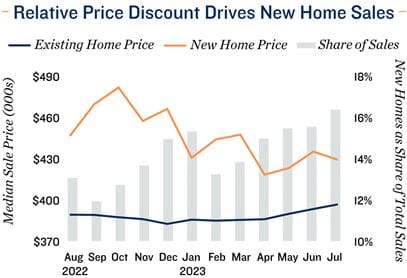Misaligned New and Existing Home Sales
Trends Depict a Market in Flux
Single-family debt costs eclipse long-standing high point. In the latter half of August 2023, the average 30-year fixed-rate mortgage surpassed 7.2 percent, up about 170 basis points from one year ago and the highest figure in more than two decades. With federal student loan obligations set to resume in October, taking on long-term debt at a 23-year high rate will continue to dissuade prospective first-time homebuyers, in turn bolstering apartment demand. Additionally, elevated mortgage rates deter existing homeowners from listing, providing pricing reinforcement amid a historic shortage of options, especially at the lower end of the cost spectrum. In July 2023, the number of existing homes for sale held about 40 percent below the trailing 10-year same month average. Concurrently, the median price ascended to a 13-month high at $396,700, the fourth-most expensive measure on record.

Gap between new and existing home prices is tightening. While the existing home market has been stalled by insufficient inventory and rising prices, newly-built houses comprise an increasingly large portion of total sales. In July, new homes accounted for roughly 16 percent of overall transactions, compared to a share of about 11 percent in the same month of 2022. This trend correlates with newly-built dwellings becoming comparatively less expensive. The gap between the median sale price of each segment tightened to $32,400 in July, a relative discount that helped push new home sales to a 17-month high. Purchases of newly-built houses are ramping up, yet it has not translated to existing homes coming to market, implying that a portion of this activity stems from first-time homeowners making a direct leap into newly-built houses.
New homes are still not attainable for many first-time buyers. While recent indicators signal that some residents are entering homeownership via a newly-built home, that is not expected to be a long-term trend. From a cost standpoint, new homes still command higher prices than existing options, limiting the number of residents that can afford to buy. Locational factors play a role as well, with many newly-built homes being constructed in outlying areas well distant of city centers and employment hubs.
Developing Trends
Multifamily project starts contract to 22-month low. The apartment sector is enduring historic construction activity at an inopportune time of soft demand, which has pushed up vacancy and curbed rent growth. Early signs of a medium-term development deceleration have begun to emerge, however, as multifamily project starts in July 2023 were at the lowest mark since September 2021. Multifamily permit issuance was also down more than 30 percent year-over-year in July, further hinting at apartment builders starting to tap the brakes. While the nation still faces a housing shortage not set to alleviate in the near term, a thinning construction pipeline could help stabilize the multifamily sector.
Material and insurance costs heighten development hurdles. The average insurance cost per apartment unit rose by 33 percent year-over-year in the second quarter, with several Florida, Texas and California metros noting much larger hikes. These added expenses, alongside the construction cost index jumping to an all-time high in August 2023, are cooling development. Single-family homebuilder confidence also dipped to a three-month low.
-16.3% |
31.5% |
| Year-Over-Year Change in Existing Home Sales in July | Year-Over-Year Change in New Home Sales in July |
Sources: Marcus & Millichap Research Services; Capital Economics; Freddie Mac; Moody’s Analytics; Mortgage Bankers Association; National Association of Home Builders; National Association of Realtors; RealPage, Inc.; U.S. Bureau of Labor Statistics; U.S. Census Bureau; Wells Fargo
Source: 23-Year High Mortgage Rates Bolstering Apartment Demand

Randolph is a Multifamily Investment Sales Broker with eXp Commercial servicing Multifamily Buyers and Sellers in the Greater Chicago Area.


